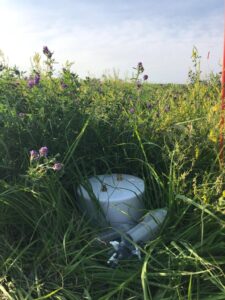Project Overview
Commodities
Practices
- Animal Production: feed/forage, pasture fertility
- Crop Production: nutrient management
- Soil Management: soil quality/health
Abstract:
Researchers and producers are challenged with developing agricultural systems that use limited resources effectively while improving productivity in the face of land degradation and increased climate variability. This is especially critical in semi-arid systems that are vulnerable to soil erosion, nutrient depletion, and extreme water scarcity. A sustainable and economically feasible management option is converting high-input row crop systems to grazed perennial grasslands, which are managed to provide high-quality forage for animal performance while improving soil health and conserving water and nutrient resources through minimized disturbance and continuous soil cover. Enteric methane (CH4) production from cattle is a potential sustainability tradeoff in these systems, but it is possible to help offset this impact through integrated soil-plant-animal management. Our two-year study leveraged long-term forage manipulations in grazed semi-arid pastures to determine how management regulated soil greenhouse gas (GHG) fluxes. We found that adding legumes can increase soil uptake of CH4 and reduce soil N2O emissions with minimal tradeoffs in CO2 emissions compared to grass-only systems, as well as increase soil microbial abundance. As water resources decline, fertilizer prices remain unstable, and climate impacts of agriculture continue to be a major mitigation target, our results provide compelling evidence that adding legumes to managed grasslands for livestock production can improve resource efficiency and sustainability. Although farmer adoption was not quantified as part of this research, engagement with producers at local and regional workshops has generated many positive discussions and interest in the potential for legumes in plant species mixes to help rebuild soil health and reduce climate footprints. The goal of continued outreach delineating the results of our study is to ultimately help us create more efficient and resilient semi-arid agricultural systems across the globe.
[caption id="attachment_1051941" align="alignnone" width="225"] Blue butterfly feeding on alfalfa bloom in study field.[/caption] [caption id="attachment_1051943" align="alignnone" width="225"]
Blue butterfly feeding on alfalfa bloom in study field.[/caption] [caption id="attachment_1051943" align="alignnone" width="225"] Static chamber for soil greenhouse gas (GHG) flux measurements in grass-legume mix study pasture.[/caption]
Static chamber for soil greenhouse gas (GHG) flux measurements in grass-legume mix study pasture.[/caption]Project objectives:
- Discover how different sources of soil nitrogen regulate the presence and activity of CH4 cycling soil microbes and GHG soil fluxes.
- Quantify how legume density influences GHG flux in established long-term pastures.